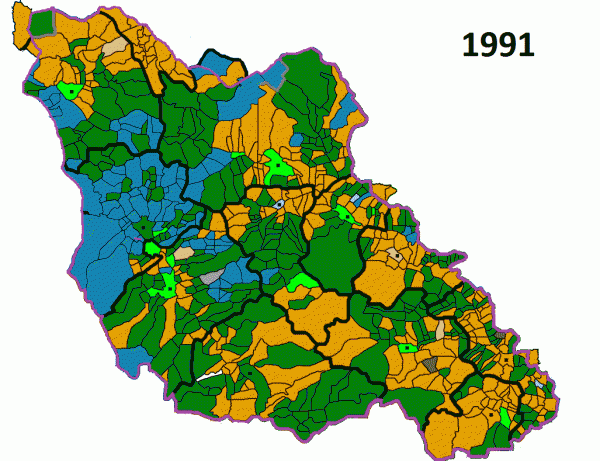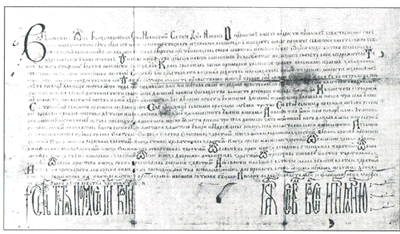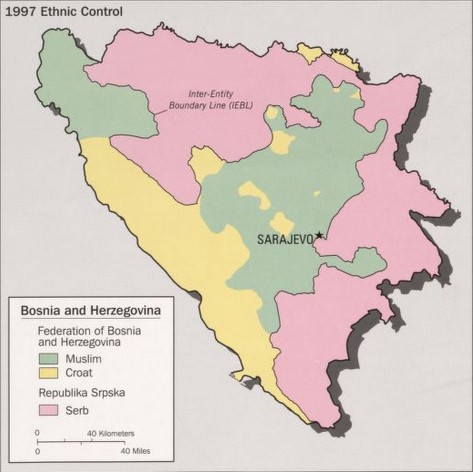|
Kreševo
Kreševo ( sr-cyrl, Крешево, ) is a town and municipality located in Central Bosnia Canton of the Federation of Bosnia and Herzegovina, an entity of Bosnia and Herzegovina. Kreševo is a mountainous town, located in a narrow valley of the Kreševka river, under the slopes of Mount Bitovnje. An old Franciscan monastery of St. Catharine is located in the town's outskirts. History Antique period The area of Kreševo was inhabited since the Neolithic period. Various material remains are indicating that a life in Kreševo was intensified during the Roman Empire, when the municipality was part of the Roman province of Illyrcicum, as well as during the Migration Period. Reason for this are the subsoil assets of the Kreševo Municipality area, where gold, silver, copper, iron and mercury where exploited. A number of the Roman aqueducts can be found on the area of the Kreševo Municipality, as well as remains of the Roman settlement near the village of Zid. During the destruct ... [...More Info...] [...Related Items...] OR: [Wikipedia] [Google] [Baidu] |
Central Bosnia Canton
The Central Bosnia Canton (, ) is one of 10 cantons of the Federation of Bosnia and Herzegovina in Bosnia and Herzegovina. The most populous settlement in the region is Bugojno, followed by Travnik and Novi Travnik. Geography It is in the country's center, west of Sarajevo. The center of canton government is Travnik. Municipalities The canton is split into the municipalities of Bugojno, Busovača, Dobretići, Donji Vakuf, Fojnica, Gornji Vakuf-Uskoplje, Jajce, Kiseljak, Kreševo, Novi Travnik, Travnik, Vitez. The region reports a GDP equitable with the average of Bosnia and Herzegovina more broadly. The region has historically benefitted from and economically relied on agriculture, trade, as well as mineral deposits. The Central Bosnia Canton is the fifth largest of ten and its share of the national population is slightly below average. In April 2022, the United Nations Office for Disaster Risk Reduction recognized the region in a climate resilience initiativ ... [...More Info...] [...Related Items...] OR: [Wikipedia] [Google] [Baidu] |
Kingdom Of Bosnia
The Kingdom of Bosnia ( / Краљевина Босна), or Bosnian Kingdom (''Bosansko kraljevstvo'' / Босанско краљевство), was a medieval kingdom that lasted for nearly a century, from 1377 to 1463, and evolved out of the Banate of Bosnia, which itself lasted since at least 1154. King Tvrtko I of Bosnia, Tvrtko I (r. 1353–91) acquired portions of western Serbia and most of the Adriatic coast south of the Neretva River. During the late part of his reign, Bosnia became one of the strongest states in the Balkans, Balkan Peninsula. However, feudal fragmentation remained important in Bosnia and the Bosnian nobility held significant power, exercising it at the Stanak meetings where members deliberated on matters such as Royal elections, election of the new king or queen and coronations, foreign policy, sale or cession of territory, contracting and signing treaties with neighboring countries, and military issues. The Ottoman Empire Ottoman conquest of Bosnia a ... [...More Info...] [...Related Items...] OR: [Wikipedia] [Google] [Baidu] |
Kreševka River
Kreševka ( sr-cyr, Крешевка; also called ''Kreševčica'' (Крешевчица) by the local population) is a small river passing through Kreševo in central part of Bosnia and Herzegovina Bosnia and Herzegovina, sometimes known as Bosnia-Herzegovina and informally as Bosnia, is a country in Southeast Europe. Situated on the Balkans, Balkan Peninsula, it borders Serbia to the east, Montenegro to the southeast, and Croatia to th .... The Kreševka is left and main tributary of the Lepenica River. The Kreševka and the Lepenica confluence is at the entrance of Kiseljak. Rivers of Bosnia and Herzegovina {{BosniaHerzegovina-river-stub ... [...More Info...] [...Related Items...] OR: [Wikipedia] [Google] [Baidu] |
Visoko
Visoko ( sr-cyrl, Високо, ) is a city located in the Zenica-Doboj Canton of the Federation of Bosnia and Herzegovina, an entity of Bosnia and Herzegovina. As of 2013, the municipality had a population of 39,938 inhabitants with 11,205 living in Visoko town. Located between Zenica and Sarajevo, Visoko lies where the river Fojnička River, Fojnica joins the Bosna (river), Bosna. The Visoko region has evidence of long continuous occupation, with the first traces of life dating back to the 5th millennium BC. Neolithic site Okolište, Archaeological excavations of Okolište have found one of the biggest Neolithic settlements of the Butmir culture in southeastern Europe. It was an Visoko during the Middle Ages, early political and commercial center of the Bosnian medieval state, and Mile (Visoko), the site where the first Bosnian king Tvrtko I was crowned. The Old town of Visoki, Old town Visoki, located on Visočica hill, was a politically important fortress, and its inner bail ... [...More Info...] [...Related Items...] OR: [Wikipedia] [Google] [Baidu] |
Federation Of Bosnia And Herzegovina
The Federation of Bosnia and Herzegovina (Serbo-Croatian: ''Federacija Bosne i Hercegovine'' / ''Федерација Босне и Херцеговине'') is one of the two Political divisions of Bosnia and Herzegovina, entities composing Bosnia and Herzegovina, the other being Republika Srpska. The Federation of Bosnia and Herzegovina consists of ten autonomous Cantons of the Federation of Bosnia and Herzegovina, cantons with their own governments and legislatures. The Federation was created by the 1994 Washington Agreement (1994), Washington Agreement, which ended the Croat–Bosniak War within the Bosnian War, and established a constituent assembly that continued its work until October 1996. The Federation has a Sarajevo, capital, Government of the Federation of Bosnia and Herzegovina, government, president, parliament, customs and police departments and two postal systems. It occupies about half of the land of Bosnia and Herzegovina. From 1996 until 2005 it had its own a ... [...More Info...] [...Related Items...] OR: [Wikipedia] [Google] [Baidu] |
Sarajevo
Sarajevo ( ), ; ''see Names of European cities in different languages (Q–T)#S, names in other languages'' is the Capital city, capital and List of cities in Bosnia and Herzegovina, largest city of Bosnia and Herzegovina, with a population of 275,524 in its administrative limits. The Sarajevo metropolitan area with its surrounding municipalities has a population of 592,714 people. Located within the greater Sarajevo valley of Bosnia (region), Bosnia, it is surrounded by the Dinaric Alps and situated along the Miljacka River in the heart of the Balkans, a region of Southeastern Europe. Sarajevo is the political, financial, social, and cultural centre of Bosnia and Herzegovina and a prominent centre of culture in the Balkans. It exerts region-wide influence in entertainment, media, fashion, and the arts. Due to its long history of religious and cultural diversity, Sarajevo is sometimes called the "Jerusalem of Europe" or "Jerusalem of the Balkans". It is one of a few major Europea ... [...More Info...] [...Related Items...] OR: [Wikipedia] [Google] [Baidu] |
Municipalities Of Bosnia And Herzegovina
In Bosnia and Herzegovina, the smallest administrative unit is the municipality ("''opština''/општина" or "''općina''/опћина" in the official languages and scripts of the country). Prior to the 1992–95 Bosnian War there were 109 municipalities in what was then Socialist Republic of Bosnia and Herzegovina. Ten of these formed the area of the capital Sarajevo. After the war, the number of municipalities was increased to 143, grouped in the following way: *79 municipalities constitute the Federation of Bosnia and Herzegovina (FBiH), which comprises 51% of the country's total territory. The municipalities within the federation are grouped into ten cantons. *64 municipalities constitute the Republika Srpska (RS), which comprises 49% of the country's total territory. In addition, Brčko District does not belong to either entity and is governed as a condominium of both FBiH and RS entities. The district corresponds to the pre-war Brčko municipality. Although tec ... [...More Info...] [...Related Items...] OR: [Wikipedia] [Google] [Baidu] |
Bosnia And Herzegovina
Bosnia and Herzegovina, sometimes known as Bosnia-Herzegovina and informally as Bosnia, is a country in Southeast Europe. Situated on the Balkans, Balkan Peninsula, it borders Serbia to the east, Montenegro to the southeast, and Croatia to the north and southwest, with a coast on the Adriatic Sea in the south. Bosnia (region), Bosnia has a moderate continental climate with hot summers and cold, snowy winters. Its geography is largely mountainous, particularly in the central and eastern regions, which are dominated by the Dinaric Alps. Herzegovina, the smaller, southern region, has a Mediterranean climate and is mostly mountainous. Sarajevo is the capital and the largest city. The area has been inhabited since at least the Upper Paleolithic, with permanent human settlement traced to the Neolithic cultures of Butmir culture, Butmir, Kakanj culture, Kakanj, and Vučedol culture, Vučedol. After the arrival of the first Proto-Indo-Europeans, Indo-Europeans, the area was populated ... [...More Info...] [...Related Items...] OR: [Wikipedia] [Google] [Baidu] |
List Of Cities In Bosnia And Herzegovina
This is a list of city, cities and towns with over 10,000 inhabitants (or lower if the municipality has over 20,000 inhabitants) in Bosnia and Herzegovina. For the full list of populated places, see List of populated places in Bosnia and Herzegovina. Organization Apart from entities, cantons and municipalities, Bosnia and Herzegovina also has officially designated cities. Official cities have their own mayor and city council, which is a big difference to the municipalities of Bosnia and Herzegovina, which have a municipal council and mayor. Powers of city councils of official cities are between the government of municipalities and government cantons in the Federation of Bosnia and Herzegovina or a government entity in Republika Srpska. There are thirty five official cities in Bosnia and Herzegovina (as of 2024): *Banja Luka *Bijeljina *Bihać *Bosanska Krupa *Brčko *Cazin *Čapljina *Derventa *Doboj *Goražde *Gračanica, Bosnia and Herzegovina, Gračanica *Gradačac *Gradi ... [...More Info...] [...Related Items...] OR: [Wikipedia] [Google] [Baidu] |
Iron
Iron is a chemical element; it has symbol Fe () and atomic number 26. It is a metal that belongs to the first transition series and group 8 of the periodic table. It is, by mass, the most common element on Earth, forming much of Earth's outer and inner core. It is the fourth most abundant element in the Earth's crust, being mainly deposited by meteorites in its metallic state. Extracting usable metal from iron ores requires kilns or furnaces capable of reaching , about 500 °C (900 °F) higher than that required to smelt copper. Humans started to master that process in Eurasia during the 2nd millennium BC and the use of iron tools and weapons began to displace copper alloys – in some regions, only around 1200 BC. That event is considered the transition from the Bronze Age to the Iron Age. In the modern world, iron alloys, such as steel, stainless steel, cast iron and special steels, are by far the most common industrial metals, due to their mechan ... [...More Info...] [...Related Items...] OR: [Wikipedia] [Google] [Baidu] |
Mercury (element)
Mercury is a chemical element; it has Symbol (chemistry), symbol Hg and atomic number 80. It is commonly known as quicksilver. A Heavy metal element, heavy, silvery d-block element, mercury is the only metallic element that is known to be liquid at standard temperature and pressure; the only other element that is liquid under these conditions is the halogen bromine, though metals such as caesium, gallium, and rubidium melt just above room temperature. Mercury occurs in deposits throughout the world mostly as cinnabar (mercuric sulfide). The red pigment vermilion is obtained by Mill (grinding), grinding natural cinnabar or synthetic mercuric sulfide. Exposure to mercury and mercury-containing organic compounds is toxic to the nervous system, immune system and kidneys of humans and other animals; mercury poisoning can result from exposure to water-soluble forms of mercury (such as mercuric chloride or methylmercury) either directly or through mechanisms of biomagnification. Mercu ... [...More Info...] [...Related Items...] OR: [Wikipedia] [Google] [Baidu] |






